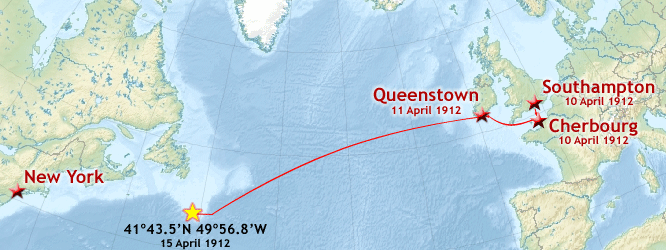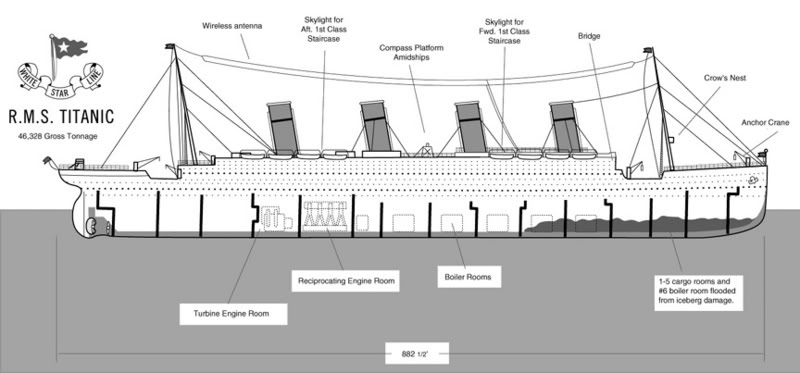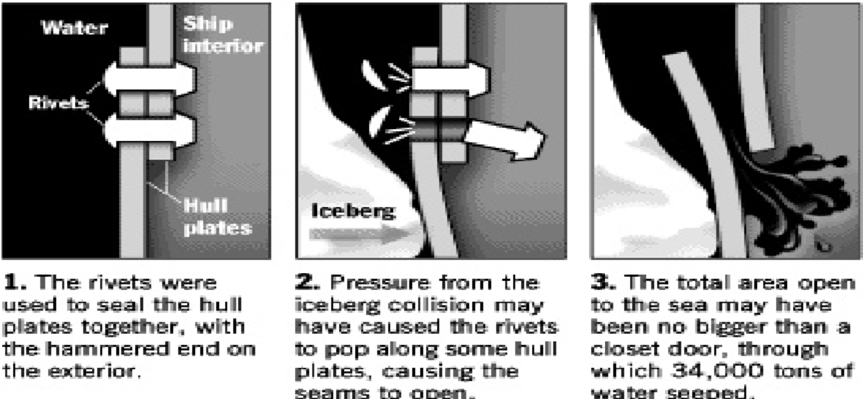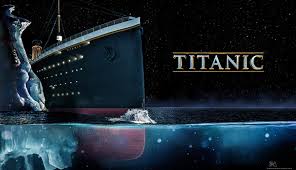 The R.M.S. Titanic was the world’s largest man-made, mobile object when the ship was commissioned in 1912. Everyone knows the Titanic hit an iceberg in the North Atlantic and sank within 2 hours and 40 minutes. It was the highest-profile marine disaster of all time and most people still blame the accident on the iceberg. What few people know is the real root cause — the fatal flaw that sunk the Titanic and killed over 1,500 people.
The R.M.S. Titanic was the world’s largest man-made, mobile object when the ship was commissioned in 1912. Everyone knows the Titanic hit an iceberg in the North Atlantic and sank within 2 hours and 40 minutes. It was the highest-profile marine disaster of all time and most people still blame the accident on the iceberg. What few people know is the real root cause — the fatal flaw that sunk the Titanic and killed over 1,500 people.
There were two official inquiries into the Titanic’s sinking. Both concluded the iceberg was the root cause, although the investigation processes considered many contributing factors — natural, mechanical, and human. There were errors found in the Titanic’s design, production, navigation, communication, and especially in the motivation of its builder, the White Star Line. While fingers were pointed, no blame was attached and the only real outcome of the Titanic inquiries was adopting the International Convention for the Safety of Life at Sea (SOLAS) that still governs marine safety today.
 The Titanic accident investigations used the best resources of the time however, the inquiries were conducted long before the wreckage was found, a forensic analysis was applied, and computer-generated recreation was available. Today, we have a clear picture of exactly how the Titanic disaster took place from a mechanical perspective but finding the root cause has remained buried as deep as its bow in the muddy bottom. It shouldn’t be, because the true cause of what really sunk the Titanic is clearly obvious when analyzed objectively.
The Titanic accident investigations used the best resources of the time however, the inquiries were conducted long before the wreckage was found, a forensic analysis was applied, and computer-generated recreation was available. Today, we have a clear picture of exactly how the Titanic disaster took place from a mechanical perspective but finding the root cause has remained buried as deep as its bow in the muddy bottom. It shouldn’t be, because the true cause of what really sunk the Titanic is clearly obvious when analyzed objectively.
Both official inquiries into the Titanic sinking called sworn testimony of the surviving crew members, passengers, rescuers, builders, and marine regulators. They used an adversarial approach that was common for investigations at the time. That involved formulating a conclusion — the iceberg — then calling selective evidence and presenting in a way that supported the iceberg findings.
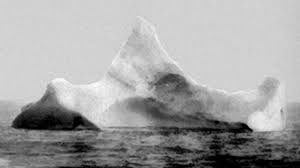 One investigation by the U.S. Senate concluded the accident was an Act of God — the iceberg was a natural feature and shouldn’t have been there under normal conditions. The second investigation by the British Wreck Commissioner agreed with the natural cause conclusion but qualified it with a statement, “What was a mistake in the case of the Titanic would, without a doubt, be negligence in any similar case in the future“. In other words, “In hindsight, it shouldn’t have happened and we’re not going to tolerate it again.”
One investigation by the U.S. Senate concluded the accident was an Act of God — the iceberg was a natural feature and shouldn’t have been there under normal conditions. The second investigation by the British Wreck Commissioner agreed with the natural cause conclusion but qualified it with a statement, “What was a mistake in the case of the Titanic would, without a doubt, be negligence in any similar case in the future“. In other words, “In hindsight, it shouldn’t have happened and we’re not going to tolerate it again.”
Both twentieth-century investigations concluded that when the Titanic collided with the iceberg, a gigantic gash was ripped in its hull allowing massive water ingress and compromising the ship’s buoyancy. At the root of the accident, they found the cause to be simply the iceberg.
They were wrong. They failed to identify the real cause of the Titanic tragedy.
Today’s professional accident investigators take a different approach to fact finding. They take a “Root Cause Approach” to accident investigation and the industry leaders in Root Cause Analysis or Cause Mapping are the front line company Think Reliability.
 Think Reliability has done a root cause analysis of the Titanic sinking that’s outlined in an instructional video and a detailed event flow chart that identifies over 100 points of contributing factors. They’re excellent presentations but even Think Reliability missed a few contributors and did not categorically identify the one fatal flaw that caused the deaths of so many innocent people.
Think Reliability has done a root cause analysis of the Titanic sinking that’s outlined in an instructional video and a detailed event flow chart that identifies over 100 points of contributing factors. They’re excellent presentations but even Think Reliability missed a few contributors and did not categorically identify the one fatal flaw that caused the deaths of so many innocent people.
In getting to the root cause and finding the fatal flaw, it’s necessary to look at the stages of how the Titanic came to be and then determine exactly what caused it to go down.
History of the Titanic
The Royal Mail Ship Titanic was one of three sister vessels planned by the British ocean liner company, White Star Line. The Olympic was commissioned in 1910 and already in operation when the Titanic was under construction. A third ship, the Britannic, was in planning.
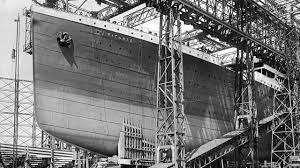 The Titanic’s construction was under an extremely tight timeline. Politics were at work, as was economics. Transcontinental ocean travel was rapidly expanding and the once-dominated British control on this lucrative industry was being threatened by German built and operated liners. In protective reaction, the British Government decided to subsidize White Star’s competitor, the Cunard Line. This left White Star resorting to private funding in order to compete and it came from American financier, J.P. Morgan, who put tremendous pressure on White Star to perform.
The Titanic’s construction was under an extremely tight timeline. Politics were at work, as was economics. Transcontinental ocean travel was rapidly expanding and the once-dominated British control on this lucrative industry was being threatened by German built and operated liners. In protective reaction, the British Government decided to subsidize White Star’s competitor, the Cunard Line. This left White Star resorting to private funding in order to compete and it came from American financier, J.P. Morgan, who put tremendous pressure on White Star to perform.
Harland & Wolff shipbuilders in Belfast, Ireland, built the Titanic. She was 883 feet long, stood 175 feet to the top of the funnels from the waterline and weighed 46,329 tons in water displacement. Her keel was laid in March, 1909, and was set to sea trials on April 2, 1912. Eight days later, on April 10, 1912, the Titanic disembarked Southampton, England on her maiden voyage destined for New York City. Officially, 2165 passengers and crew were on board but this figure is not accurate due to no-shows, an inaccurate crew count, and additional passengers who were taken on in Ireland as well as inevitable stowaways.
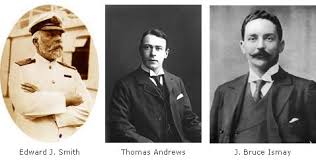 Some of the world’s most influential and wealthy people were on the Titanic which included the ship’s designer, Thomas Andrews, as well as the head of White Star Line, Bruce Ismay. It was beyond a voyage — it was a cultural event and a chance for White Star to regain its place in international shipping by proving the fastest and most luxurious way to sail between Europe and America. A lot was riding on the Titanic’s success.
Some of the world’s most influential and wealthy people were on the Titanic which included the ship’s designer, Thomas Andrews, as well as the head of White Star Line, Bruce Ismay. It was beyond a voyage — it was a cultural event and a chance for White Star to regain its place in international shipping by proving the fastest and most luxurious way to sail between Europe and America. A lot was riding on the Titanic’s success.
The Iceberg Collision
The route Titanic took to New York had been traveled for several hundred years. It was the standard passageway for international liners and the main shipping lane between Europe and North America. The Titanic’s master, Captain Edward Smith, was a thirty-two-year White Star Line veteran and was chosen to command the Titanic due to his experience in international navigation, specifically this plot.
On the evening of April 14, 1912, the weather was perfect. It was clear, cold, and the sea was flat calm however, visibility was limited to ¼ mile due to there being a new moon and the only illumination was from starlight.
At 11:35 p.m., the Titanic approached a point 375 nautical miles south-southeast of Newfoundland where the cold Labrador current from the north met the warmer Gulf current from the south. This location was well known for being the edge of pack ice and was notorious for icebergs which calf or break-off from their parent shelf.
Captain Smith had inspected the bridge at approximately 9:30 p.m. According to testimony from the surviving helmsman, Captain Smith discussed the potential of icebergs although none were yet seen. Smith directed the helmsman to maintain course and to raise him if conditions changed. The Captain left the bridge, retiring to his quarters. He was no longer involved in mastering the ship until after the collision.
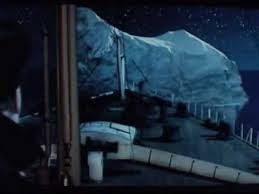 Testimony from the Titanic’s helmsman, Robert Hitchens who was at the wheel during the iceberg collision, records that the Titanic was at 75 propeller revolutions per minute which calculated to 22.5 nautical miles per hour, just short of its maximum design speed of 80 revolutions or 24 knots. The helmsman also testified the Titanic was actually speeding up when it struck the iceberg as it was White Star chairman and managing director, Bruce Ismay’s, intention to run the rest of the route to New York at full speed, arrive early, and prove the Titanic’s superior performance. Ismay survived the disaster and testified at the inquiries that this speed increase was approved by Captain Smith and the helmsman was operating under his Captain’s direction.
Testimony from the Titanic’s helmsman, Robert Hitchens who was at the wheel during the iceberg collision, records that the Titanic was at 75 propeller revolutions per minute which calculated to 22.5 nautical miles per hour, just short of its maximum design speed of 80 revolutions or 24 knots. The helmsman also testified the Titanic was actually speeding up when it struck the iceberg as it was White Star chairman and managing director, Bruce Ismay’s, intention to run the rest of the route to New York at full speed, arrive early, and prove the Titanic’s superior performance. Ismay survived the disaster and testified at the inquiries that this speed increase was approved by Captain Smith and the helmsman was operating under his Captain’s direction.
The Titanic was built long before radar became the main nighttime navigational aid. The watch depended on a crew member in the forward crow’s-nest who stared through the dark for obstacles. Other ships were not a concern as they were brightly lit and the only threat to the Titanic was an iceberg.
 From the dim, Titanic’s watchman saw the shape of an iceberg materialize. It was estimated at ten times the Titanic’s size above water, which equates to a total mass of one hundred Titanics. The watchman alerted the bridge that an iceberg was at the front right, or starboard side, and to alter course.
From the dim, Titanic’s watchman saw the shape of an iceberg materialize. It was estimated at ten times the Titanic’s size above water, which equates to a total mass of one hundred Titanics. The watchman alerted the bridge that an iceberg was at the front right, or starboard side, and to alter course.
Testimony shows that confusion may have caused a mistake being made in relaying a course change from the bridge to the steerage located at the ship’s stern. It appears the rudder might have been swung in the wrong direction and they accidently turned into the iceberg. It’s reported that when the helmsman realized the error, he ordered all engines in full reverse. Screw and rudder ships cannot steer in reverse. They can only back up in a straight line but it was too late.
Stopping the Titanic was impossible. It was speeding ahead far too fast to brake within a 1/4 mile, which is 440 yards. Without a speed reduction, covering 440 yards at 22.5 nautical miles per hour would take 36 seconds. Testimony from the inquiries recorded that during the eight-day sea trials, the Titanic was tested from full-ahead at 22 knots to full-stop. This took 3 minutes and 15 seconds and the deceleration covered 850 yards.
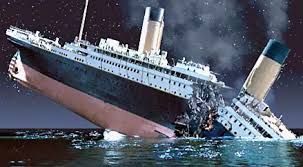 The Titanic sideswiped the iceberg on its starboard front, exchanging a phenomenal amount of energy. It immediately began taking on water that filled the ship’s six forward hull compartments. Water cascaded over the tops of the bulkheads in a domino effect and, as the weight of the water pulled the bow down, more water ingressed. This caused the stern to rise above the waterline. With the rear third of the ship losing buoyancy and the weight from her propellers being in the air, the stress on the ship’s midpoint caused a fracture. The ship split in two and quickly sank to the bottom. It was 2:20 a.m. on April 15, 1912 — two hours and twenty minutes after the iceberg collision.
The Titanic sideswiped the iceberg on its starboard front, exchanging a phenomenal amount of energy. It immediately began taking on water that filled the ship’s six forward hull compartments. Water cascaded over the tops of the bulkheads in a domino effect and, as the weight of the water pulled the bow down, more water ingressed. This caused the stern to rise above the waterline. With the rear third of the ship losing buoyancy and the weight from her propellers being in the air, the stress on the ship’s midpoint caused a fracture. The ship split in two and quickly sank to the bottom. It was 2:20 a.m. on April 15, 1912 — two hours and twenty minutes after the iceberg collision.
Warning and Life Saving Attempts
Captain Smith came to the bridge shortly after the collision. Again, survivor testimony is conflicting and Smith did not live to give his version of what took place in mustering the crew and passengers for safe abandonment.
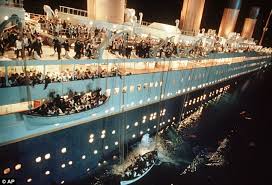 Without any doubt, there was complete confusion — some said utter chaos — in abandoning ship. The voyage had been so hastily pushed that the crew had no specific training or conducted any drills in lifesaving on the Titanic , being unfamiliar with the lifeboats and their davit lowering mechanisms.
Without any doubt, there was complete confusion — some said utter chaos — in abandoning ship. The voyage had been so hastily pushed that the crew had no specific training or conducted any drills in lifesaving on the Titanic , being unfamiliar with the lifeboats and their davit lowering mechanisms.
Compounding this was a decision by White Star management to equip the Titanic with only half the necessary lifeboats to handle the number of people onboard. The reasons are long established. White Star felt a full complement of lifeboats would give the ship an unattractive, cluttered look. They also clearly had a false confidence the lifeboats would never be needed.
It’s well documented that many lifeboats discharged from the Titanic weren’t filled to capacity. Partly at fault was a “women and children first” mentality, but the primary reason is that no one person took charge of the operation. Testimony is clear that Captain Smith was involved during the lifeboat discharges but there’s no record of what charge he actually took. Some accounts tell of the Captain remaining on the bridge and going down with the ship, as the old mariner’s line goes.
 Another well-documented issue was the failure of the ocean liner Californian to come to Titanic’s rescue. The Californian was within visual view of the Titanic. In fact, the crew of the Californian had sent the Titanic repeated messages warning of icebergs and the Californian had stopped for the night because of limited visibility and high risk of iceberg collision. These messages were improperly addressed and were never relayed to the bridge of the Titanic.
Another well-documented issue was the failure of the ocean liner Californian to come to Titanic’s rescue. The Californian was within visual view of the Titanic. In fact, the crew of the Californian had sent the Titanic repeated messages warning of icebergs and the Californian had stopped for the night because of limited visibility and high risk of iceberg collision. These messages were improperly addressed and were never relayed to the bridge of the Titanic.
Further, the crew of the Californian had seen Titanic’s distress flares but the Californian’s Captain refused to respond. This was a major issue brought up at both official inquiries and a reasonable explanation from Californian’s Captain was never resolved.
Eventually, the ocean liner Carpathia responded. It, too, sent the Titanic iceberg warnings before the collision. The inquiries drilled down into the message relay flaws. They discovered the wireless operators on board the Titanic weren’t crewmembers nor directed by White Star. They were employees of the Marconi Telegraph Company privately contracted in a for-profit role to deliver all messages to and from the Titanic. In the few hours before the iceberg collision, the Titanic was within range of an on-shore relay station and this gave them a short window to pass high-priority messages for wealthy passengers. Navigation warning messages to the Titanic were given low or no priority.
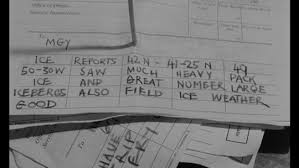 Hearing testimony recorded that shortly after dark, as early as 7:00 p.m., the Titanic was sent at least five iceberg warnings. There’s no record these were passed on to the ship’s bridge nor the Captain. The Marconi operator aboard the Titanic survived to testify there’d been a severe backlog of paying customer messages and he was being “interrupted” by incoming navigational alerts. The warnings were set aside as they were not addressed “MSG” which means “Master Service Gram”. By policy, MSG messages required the Captain’s personal action whereas non-marked messages were delivered when time permitted.
Hearing testimony recorded that shortly after dark, as early as 7:00 p.m., the Titanic was sent at least five iceberg warnings. There’s no record these were passed on to the ship’s bridge nor the Captain. The Marconi operator aboard the Titanic survived to testify there’d been a severe backlog of paying customer messages and he was being “interrupted” by incoming navigational alerts. The warnings were set aside as they were not addressed “MSG” which means “Master Service Gram”. By policy, MSG messages required the Captain’s personal action whereas non-marked messages were delivered when time permitted.
Finding the Titanic — Design and Damage
Although the Titanic was the largest ship of its time, there was nothing technologically new about its design, materials, or method of construction. The hull was built of large steel plates, some as large as 6 feet by 30 feet and between 1 and 1 ½ inches thick. The technology at the time was to rivet the sections together where today, modern ships are welded at their seams.
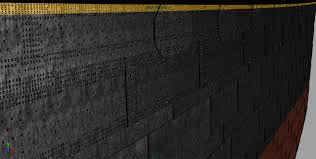 Riveting a ship’s seams was an entire trade on its own — almost an art. There were two types of rivets used on the Titanic. Rivets in the mid-section of the hull, where stresses from lateral wave forces were greatest, were made of steel and triple-riveted while those in the bow and stern were composed of cheaper iron. The bow and the stern endured less force when under normal operation and only required double riveting by design. Further, with the mid-section of the Titanic being straight and flat, these rivets were installed with hydraulic presses where the curved plates at the ship’s ends had to be hand riveted. That involved setting rivets in place while white hot and hand-hammering them closed.
Riveting a ship’s seams was an entire trade on its own — almost an art. There were two types of rivets used on the Titanic. Rivets in the mid-section of the hull, where stresses from lateral wave forces were greatest, were made of steel and triple-riveted while those in the bow and stern were composed of cheaper iron. The bow and the stern endured less force when under normal operation and only required double riveting by design. Further, with the mid-section of the Titanic being straight and flat, these rivets were installed with hydraulic presses where the curved plates at the ship’s ends had to be hand riveted. That involved setting rivets in place while white hot and hand-hammering them closed.
Anyone who’s watched the movie Titanic knows the ship was designed with sixteen “watertight” compartments, separated by fifteen bulkheads that had doors which could be shut off in the event the hull was compromised anywhere along these sections. The “watertight” design only applied below or at the waterline, leaving the entire hull open above the top of these bulkheads.
The bulkheads were the fatal design cause of the Titanic’s sinking, but they weren’t the root cause of the disaster.
The ship’s architect, Thomas Andrews, was aware that flooding of more than four compartments would create a “mathematical certainty” that the bulkheads would overflow and cause the ship to sink. Testimony records that Andrews informed Captain Smith of this right after he realized the extent of flooding. This triggered the abandon ship order.
Over the years following the sinking and before the Titanic’s wreckage was discovered, most historians and naval experts assumed the ship suffered a continuous gash in the hull below the waterline and across all six compartments. There was one dissenter, though, who surmised it only took a small amount of opening in each compartment to let in 34,000 tons of water and that was enough to compromise the ship.
Edward Wilding was a naval architect and co-designer of the Titanic who testified at the American inquiry. He calculated that as little as 12 square feet of opening in the hull would have been enough to let in that much water in the amount of time the Titanic remained afloat. Wilding stated his opinion that there was not a long gash, rather it was a “series of steps of comparatively short length, an aggregate of small holes” that were punctured in the hull. Wilding went as far to speculate that the force of the collision probably caused a number of rivets to “pop or let go” and it was “leaks at the ruptured seams” that let in seawater.
In September, 1985, the Titanic’s wreckage was found by a deep sea expedition led by Dr. Bob Ballard. It was in 12,500 feet of water and its debris field covered 2,000 yards. Her hull was in two separate main pieces with her bow nosed into 35 feet of muddy bottom. Since then, a number of dives have been made on the Titanic including one which used a ground penetrating sonar that mapped the section of the bow that was under the mud.
The sonar readings clearly showed six separate openings in the forward six hull compartments. They were narrow, horizontal slits in various spots, not at all in one continuous line like the gash theory held. The sonar map was analyzed by naval architects at Bedford & Hackett who calculated the total area exposed by the slits was 12.6 square feet—almost the exact figure proposed by Edward Wilding in 1912.
The architects also stated the rivets were clearly at fault and they’d failed from the impact. The rivets either sheared off on the outer heads or simply fractured and were released by the impact’s force. Immediately, many experts questioned why only a few rivets in a few seemingly random places failed and not most all along the area of impact.
In one of the dives, a large piece of the Titanic’s forward hull was recovered. This led to a forensic study on the plate steel and rivet composition by metallurgists Jennifer McCarty and Tim Foecke which they documented in their book What Really Sank The Titanic. Drs. McCarty and Foecke established a number of the Titanic’s iron rivets had an unacceptable amount of slag in their chemical makeup, contrary to what the ship’s design specified. The metallurgists concluded when the inferior, weak rivets were exposed in below-zero Fahrenheit water temperature on the night of the sinking, they were brittle and shattered from the collision force.
 The metallurgists went further in their investigation. They found during the rush to complete the Titanic on time, the builders purposely resorted to inferior metal than specified by the designers. The builders were also faced with a critical shortage of skilled riveting labor. This led to a compounded error of inferior rivets being installed by inferior tradesmen that likely explains the randomness of failed areas.
The metallurgists went further in their investigation. They found during the rush to complete the Titanic on time, the builders purposely resorted to inferior metal than specified by the designers. The builders were also faced with a critical shortage of skilled riveting labor. This led to a compounded error of inferior rivets being installed by inferior tradesmen that likely explains the randomness of failed areas.
Today, the failed rivet theory stands as the most logical explanation for the mechanical cause of the Titanic disaster, but this still doesn’t get at the root cause of the tragedy.
At the core of Root Cause Analysis is the question “Why?”. This form of accident investigation forces the question “Why did this happen?” to be asked over and over until you cannot ask anymore “Whys?”. In Titanic’s case, this path leads to answering the root cause — the fatal flaw in why over 1,500 innocent people lost their lives.
The two official investigations back in 1912 started with a conclusion — the Titanic hit an iceberg and sank. They made somewhat of an attempt to answer why that happened without attaching too much blame. The result was not so much as getting to the root cause but to try and make some good come from the disaster and ensure there was less chance of it happening again.
That is a good thing and, to repeat, it led to improving world marine safety through SOLAS. But that still doesn’t get to identifying the fatal flaw in what really sank the Titanic.
Think Reliability identified five root causes of the Titanic disaster:
1. Iceberg warnings were ignored.
2. The iceberg wasn’t seen until too late.
3. The Titanic was traveling too fast for visual conditions and couldn’t avoid colliding with the iceberg.
4. The rivets failed, compromising the hull’s integrity and letting in enough water to exceed the design buoyancy.
5. Insufficient lifesaving procedures and equipment were in place.
While these five reasons are the prime contributors to why the accident and tremendous loss of life happened, they still don’t arrive at the true, single root cause — the fatal flaw in what caused the Titanic tragedy.
Finding the fatal flaw requires answering ‘Why” to each of these five points.
1. Why were the iceberg warnings ignored?
The answer is a systematic failure of communication operating on the Titanic. There was ample reason to suspect icebergs might be in the Titanic’s path. Any competent captain would be aware of hazards like this and would liaise with other ships along the route for warning information. Navigational communication was not a priority under Captain Smith’s command.
2. Why was the iceberg not seen until too late?
There’s another simple answer here. Night visibility was poor as there was limited light. Testimony from the surviving crewmembers consistently estimated the visibility range to be no more than ¼ mile. Eyesight, combined with compass readings, were the only forms of navigation in 1912. The Titanic was going too fast for the crew to react because Captain Smith allowed his ship to exceed a safe speed for navigation conditions.
3. Why was the Titanic traveling too fast for navigation conditions?
Without question, Captain Smith was under pressure from Bruce Ismay to bring the Titanic into New York earlier than scheduled. While this would never have set a speed record for the route, it certainly would reflect positively on the White Star Line and its business futures. Captain Smith succumbed to unreasonable pressure and allowed his ship to be operated unsafely.
4. Why did the rivets fail?
While Captain Smith had no input into the construction of the Titanic, he certainly knew its design limits. The Titanic was built as an ocean liner, not a battleship or an icebreaker. Captain Smith knew how dangerous an iceberg collision could be yet he still risked his ship being operated in unsafe conditions.
5. Why were there insufficient lifesaving equipment and procedures in place?
The fault began with White Star’s failure to provide the proper amount of lifeboats as well as rushing the Titanic into service before the crew was properly trained in drills and equipment operation. Captain Smith was aware of this. Despite, he allowed the Titanic to sail unprepared.
 At the root of each of question lies irresponsibility of the Titanic’s captain. It’s long held in marine law that a ship’s captain is ultimately responsible for the safety of the vessel, the crew, and the passengers.
At the root of each of question lies irresponsibility of the Titanic’s captain. It’s long held in marine law that a ship’s captain is ultimately responsible for the safety of the vessel, the crew, and the passengers.
Captain Smith had full authority over every stage in the Titanic’s disaster and he failed on each point. Clearly, Captain Smith is the fatal flaw that caused the Titanic tragedy.


